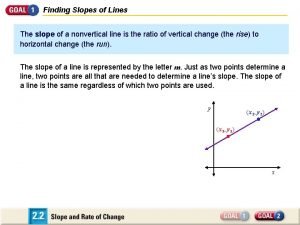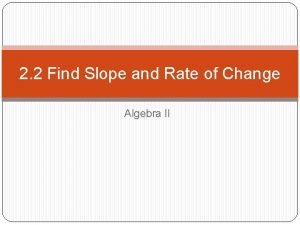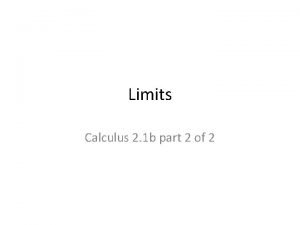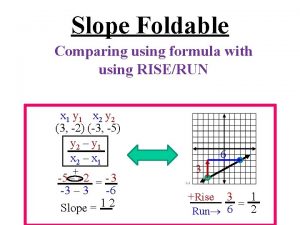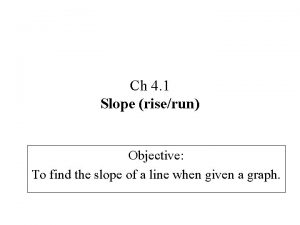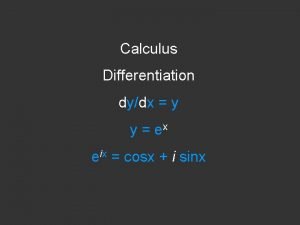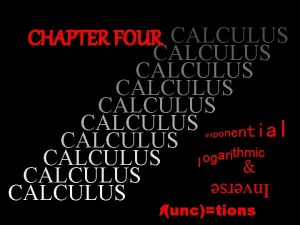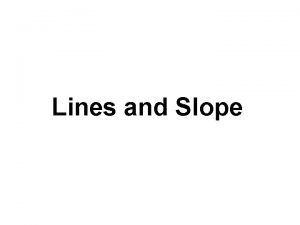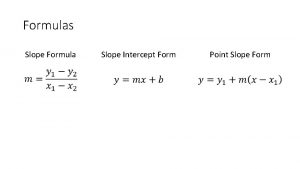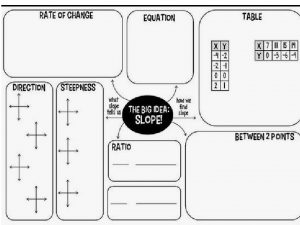Calculus Review Slope Slope riserun DyDx y 2













![Numerical Derivatives • slope between points • MATLAB – c=[]; – [dcdx, dcdy]=gradient(c) – Numerical Derivatives • slope between points • MATLAB – c=[]; – [dcdx, dcdy]=gradient(c) –](https://slidetodoc.com/presentation_image/a78b13cd6bef5eb413705c6f612b9520/image-14.jpg)


- Slides: 16

Calculus Review

Slope • Slope = rise/run • = Dy/Dx • = (y 2 – y 1)/(x 2 – x 1) • Order of points 1 and 2 not critical • Points may lie in any quadrant: slope will work out • Leibniz notation for derivative based on Dy/Dx; the derivative is written dy/dx

Exponents • x 0 = 1

Derivative of a line • • • y = mx + b slope m and y axis intercept b derivative of y = axn + b with respect to x: dy/dx = a n x(n-1) Because b is a constant -- think of it as bx 0 -- its derivative is 0 b-1 = 0 • For a straight line, a = m and n = 1 so • dy/dx = m 1 x(0), or because x 0 = 1, • dy/dx = m

Derivative of a polynomial • In differential Calculus, we consider the slopes of curves rather than straight lines • For polynomial y = axn + bxp + cxq + … • derivative with respect to x is • dy/dx = a n x(n-1) + b p x(p-1) + c q x(q-1) + …

Example y = axn + bxp + cxq + … dy/dx = a n x(n-1) + b p x(p-1) + c q x(q-1) + …

Numerical Derivatives • slope between points

Derivative of Sine and Cosine • • sin(0) = 0 period of both sine and cosine is 2 p d(sin(x))/dx = cos(x) d(cos(x))/dx = -sin(x)

Partial Derivatives • Functions of more than one variable • Example: h(x, y) = x 4 + y 3 + xy

Partial Derivatives • Partial derivative of h with respect to x at a y location y 0 • Notation dh/dx|y=y 0 • Treat ys as constants • If these constants stand alone, they drop out of the result • If they are in multiplicative terms involving x, they are retained as constants

Partial Derivatives • Example: • h(x, y) = x 4 + y 3 + xy • dh/dx|y=y 0 = 4 x 3 + y 0

WHY?

Gradients • del C (or grad C) • Diffusion (Fick’s 1 st Law):
![Numerical Derivatives slope between points MATLAB c dcdx dcdygradientc Numerical Derivatives • slope between points • MATLAB – c=[]; – [dcdx, dcdy]=gradient(c) –](https://slidetodoc.com/presentation_image/a78b13cd6bef5eb413705c6f612b9520/image-14.jpg)
Numerical Derivatives • slope between points • MATLAB – c=[]; – [dcdx, dcdy]=gradient(c) – contour([1: 20], c) – hold – quiver([1: 20], -dcdx, -dcdy)

Mathematica

Mathematica
 Margins, dydx stata
Margins, dydx stata Slope review classifying slope
Slope review classifying slope Slope review classifying slope
Slope review classifying slope Slope fields ap calculus
Slope fields ap calculus Calculus limits review
Calculus limits review Pre calculus unit 1 review
Pre calculus unit 1 review Point-slope form definition geometry
Point-slope form definition geometry Slope decline theory
Slope decline theory Nader amin-salehi
Nader amin-salehi Example of inclusion and exclusion criteria
Example of inclusion and exclusion criteria Chapter review motion part a vocabulary review answer key
Chapter review motion part a vocabulary review answer key Narrative review vs systematic review
Narrative review vs systematic review Uncontrollable spending ap gov
Uncontrollable spending ap gov Expressive power of algebra and calculus
Expressive power of algebra and calculus Formula for average rate of change
Formula for average rate of change Calculus 2 limits
Calculus 2 limits Lambda calculus
Lambda calculus

